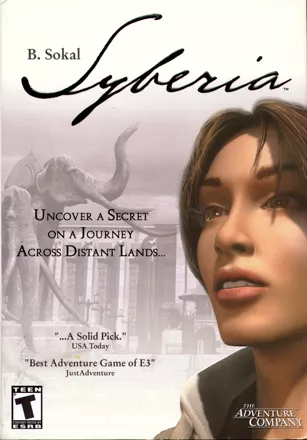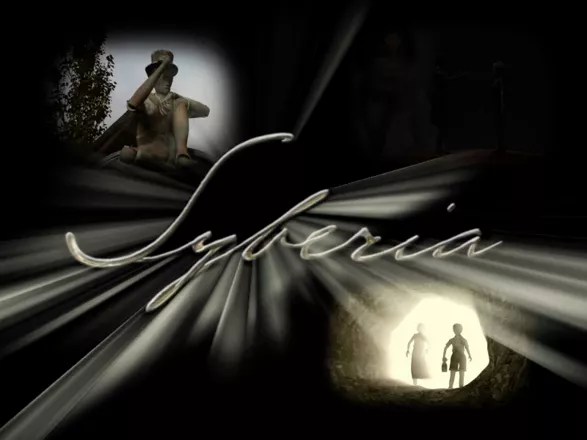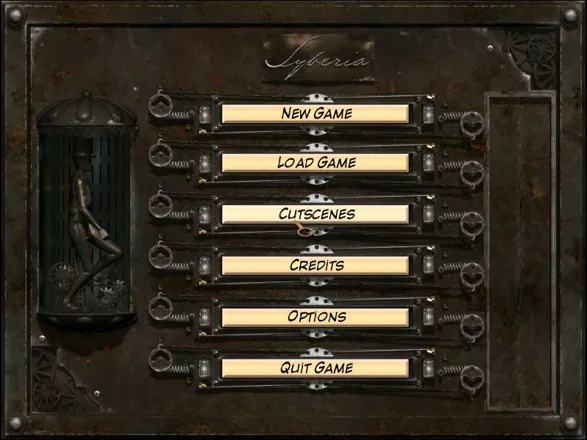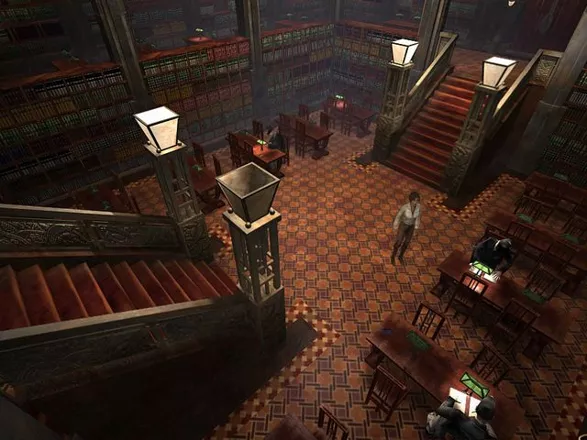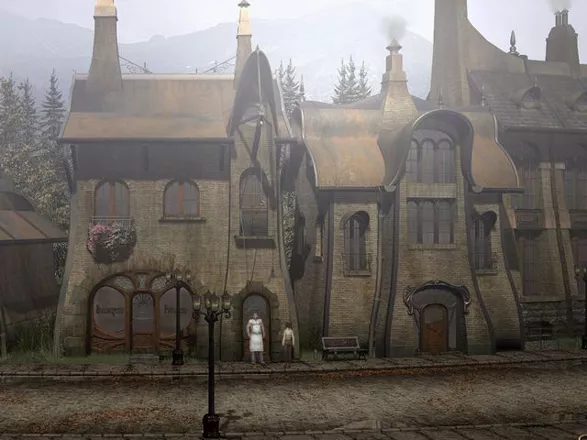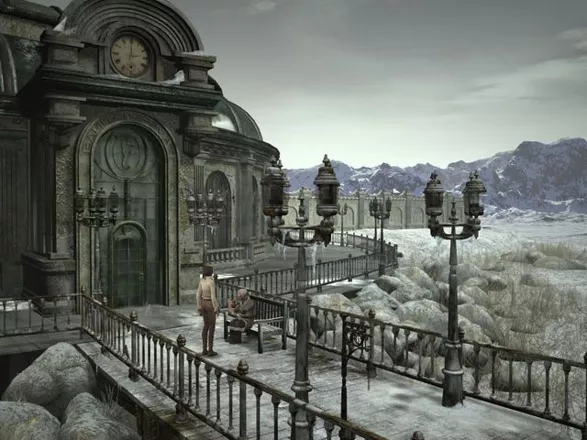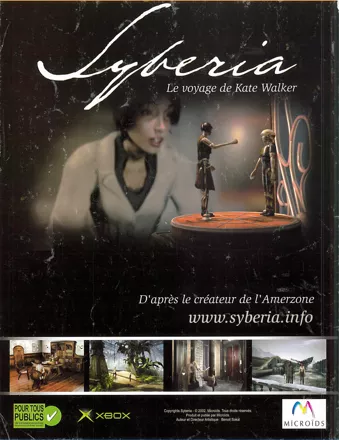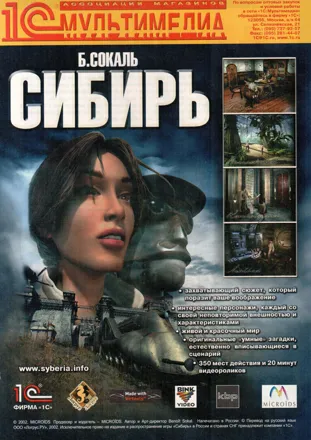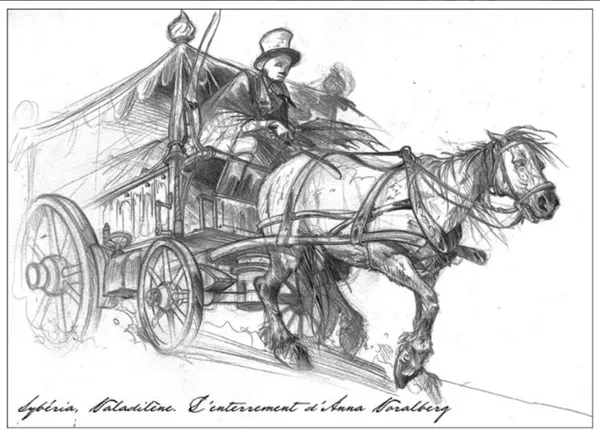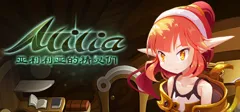Syberia
Description official descriptions
Kate Walker is a lawyer who has been entrusted by the Universal Toy Company to negotiate the takeover of an old luxury toy and automaton factory. Over the centuries, the factory has been developing clockwork devices, specializing in perpetual mechanical movement. The factory's ambitions, however, are ill-suited to the contemporary economic climate, and the elderly Anna Voralberg, at the helm of the Valadilene factory for more than half a century, has decided to sell up.
It turns out that the takeover might not be as straightforward as expected. The day that Kate Walker arrives, Anna Voralberg is being buried. What is more is that she has left an heir – her brother Hans. But Hans had left the valley at the end of the thirties and never returned, and was actually believed to be dead. However, a letter written by Anna in the days leading up to her death reveals that Hans is well and truly alive and living somewhere in Siberia. Valadilene's elderly notary entrusted to take care of Anna's affairs suggests that Kate find Hans Voralberg as he is now the only person in a position to ratify the sale of the family business.
Syberia is a traditional puzzle-solving adventure. The player navigates a 3D model of the protagonist over pre-rendered backgrounds with fixed camera angles. Puzzles are mostly inventory-based, though some involve manipulating the environment (such as mechanical devices). The interface features a single cursor; only highlighted objects can be interacted with, and there are no verb choice commands.
Spellings
- Сибирь - Russian spelling
- シベリア 日本語版 - Nintendo product page Japanese spelling
- 西伯利亞 - Traditional Chinese spelling
- 赛伯利亚 - Simplified Chinese spelling
Groups +
Screenshots
Promos
Videos
Add Trailer or Gameplay Video +1 point
See any errors or missing info for this game?
You can submit a correction, contribute trivia, add to a game group, add a related site or alternate title.
Credits (Windows version)
114 People (101 developers, 13 thanks) · View all
| Author | |
| Art Director | |
| Production Manager | |
| Technical Manager | |
| Project Manager | |
| Lead 3D Modeler & Texturing | |
| Lead 3D Animator | |
| Lead Programmer | |
| Lead Integrator | |
| France-Canada Coordinator | |
| Game Designers | |
| Writer/Editor | |
| Set Design | |
| 3D Modeling & Texture Art - Environment | |
| 3D Modeling & Texture Art - Characters | |
| Animation - Cutscenes | |
| Animation - In-game | |
| [ full credits ] | |
Reviews
Critics
Average score: 76% (based on 67 ratings)
Players
Average score: 3.9 out of 5 (based on 194 ratings with 14 reviews)
Realism and emotion - an uncommon combination
The Good
If you are reading this review, I will assume you haven't played Syberia but are thinking about it. Let me say, adventure fans, you are in for a real treat! Not only are the graphics and music really, really wonderful, the story is a captivating and evolving tale.
I was disappointed with Microids' "Myst-like" game Amerzone, and I am very pleased to tell you this game is a HUGE improvement. Not only is Syberia a 3rd person adventure, the mechanics of the game include everything I like: Easy install/uninstall, point-and-click interface, subtitles On/Off option, plenty of Save Game slots, and no disc swapping.
You'll travel to truly picturesque places where the atmosphere is alive with movement - water ripples, birds flutter, leaves blow in the wind - and the sounds of life are everywhere. The character you play is a lovely young woman named Kate Walker, a New York lawyer, sent to get a company buy-out contract signed. She moves fluidly through her surroundings and her actions are portrayed very naturally. You'd think you are watching a real actress rather than a rendered one.
The puzzles all center around "automatons" - cog, wheel and lever wind-up machines of old. None of the puzzles are difficult, and all of them are unique and well integrated into the plot. The owner of the toy company you seek was the inventor of automated toys most of which require a key or other metal part to work. (Another plus - NO maze, NO slider puzzles!)
In the midst of the beautifully rendered backgrounds plays gloriously orchestrated, classical music. When Kate accomplishes an important objective, the music changes to congratulate you. When Kate gets surprises by something, you receive different music. (Wait until you hear the opera!)
Sound effects of the automated machinery always sounded appropriate. In addition you'll hear Kate's footsteps going up and down steps, opening and closing doors, the flood of water gushing as you open a gate and many other normal sounds. These, in combination with the scenery, give you the feeling of actually "being there".
The voice acting is excellent and lip-sync is done very well. I noticed that most of the conversations do not give you a "head shot" of the other party. Therefore, lip-sync perfection was not required.
The Bad
Only a few annoyances are worthy of comment. Those include:
1. Hard-to-see cursor changes on interactive spots.
2. Extra long load times for the cut-scenes
3. Too much travel in between locations to accomplish little things
The ending was totally satisfying to me, but I wasn't expecting it to happen so fast. I finished the game in a day and a half (with breaks, of course), and it left me wanting more.
The Bottom Line
I consider Syberia fantastic - worthy of a "5 star" rating! The story is original and lifelike amidst an environment that is pleasant to explore. Puzzles are integrated well and easy to work (once you have found the proper parts). And your character evolves and grows during the course of her adventure.
By the end of the game, I actually shed a tear or two -- why, I began to care about Kate! Only a handful of games I've played in my life thus far have actually evoked that kind of emotion.
I definitely recommend this game and anxiously await the sequel.
Windows · by Jeanne (75945) · 2003
A transitional moment for adventure games
The Good
* Unique story, characters, and setting not usually seen in games
-
Good visual presentation
-
No illogical or unfair puzzles
The Bad
* Puzzles are too easy -
Script issues, including pacing
-
Hit-or-miss voice acting
The Bottom Line
Upon its release in 2002, Syberia was hailed as an instantly classic adventure game. Some even referred to it at the genre’s savior. Written and directed by Belgian comics artist Benoit Sokal, the game is a followup to his 1999 adventure Amerzone and is set in the same universe. With a low, accessible difficulty and focus on narrative, Syberia is best viewed as a transitional game between the puzzle-driven adventures of old and the modern breed of adventure games from developers such as Telltale Games and Dontnod Entertainment, which are purely narrative driven.Syberia follows the story of an American lawyer named Kate Walker. Walker is trying to close a deal between the conglomerate Universal Toys Company and the Voralberg company in France which for centuries has been manufacturing mechanical wind-up toys and automata. In the age of computers and cell phones, Voralberg’s toys have become increasingly irrelevant. When Kate arrives in France, she is surprised to discover that Anna Voralberg, the factory’s owner, and the person whose signature is needed to complete the deal, has just died. After doing some investigation, Kate discovers that the company has a secret heir - Anna’s long-lost brother Hans Voralberg. Making use of a clockwork train and driver automaton named Oscar that Hans designed, Kate undertakes a journey across Europe and Russia, through significant places in Hans’ past, to hopefully track him down. All the while, Kate’s relationship with her boyfriend Dan becomes increasingly strained as she moves farther and farther east.
Unlike most video games, Syberia’s plot is very relaxed, while still retaining an epic scope. There are conflicts to solve, but nothing particularly menacing or dangerous happens to Kate for most of the game. Everything is resolved without violence or even much conflict.The only exception to this comes during the game’s climax, which features an obvious villain trying to kill Kate. This actually comes across as quite jarring given the tone of the rest of the game, which up until that point has been focused on intimate conversation and world building, rather than action.
The visuals and settings of Syberia are one of its main selling points. Drawing from art nouveau and clockpunk designs, Syberia presents a very original setting, with technology that is primarily powered by purely mechanical, rather than electrical means. The train that Kate rides throughout the journey is entirely spring-powered and must be rewound at every stop. Even the automaton characters are implied to be using incredibly advanced mechanisms rather than electricity. Of course, technology still hasn’t advanced to the point where even an electrical automaton like what is presented here is possible, but the rest of the setting helps you buy into it. Indeed, the conflict between the past (mechanical) and present (electrical) is one of the plot’s main themes. Most of the early environments are very mechanical and retro, but as you get farther along Kate’s journey and further into Hans’ history, the designs start to be come a bit more computerized, while retaining a mechanical feel. It’s a neat trick. Technically, the game uses the popular style of the era: 3D characters superimposed over pre rendered 2D backdrops. Many backgrounds have moving FMV elements, though there are a few times when details that should be moving are static (such as flowing water) that can make some scenes look a bit odd. Animations are fine, though there are times when characters are speaking that they can sometimes appear choppy.
Mechanically, Syberia is as basic as inventory-based adventures get. Most objects can only be interacted with in one way, and nearly everything you pick up is either used to solve a puzzle or provide background information on the story. When talking to characters, Kate can choose several one-word options from a notepad which changes depending on the situation. This can make it tricky at times to figure out what Kate will actually say, as there are times where the option has the same name but the resulting dialog is different depending on the situation. I just ended up clicking on every response to see what Kate would say. Thankfully, this isn’t a choice-and-consequence game, so I could click on dialog options without fear of messing up.
Syberia is primarily a narrative driven game. It’s easy to lose yourself in the game’s characters and lore, which showcases the broad and beautiful imagination of Benoit Sokal. The game is more about simply taking in the sights, sounds, and history of the world. As a result, the puzzles of Syberia are surely among the easiest to ever appear in an adventure game. I never even looked at a walkthrough one time, and only very rarely was I even close to being stumped as to what I was actually supposed to do. The vast majority of puzzles are simple use item on object puzzles. There’s no combining items in the inventory either. The rest of the puzzles are simply about figuring out how to use an array of mechanical devices. You’ll hunt for codes and keys to start machines up, then fiddle with them for a bit until they work. Only one early puzzle required any guesswork to solve, but even then the amount of guesses it takes is very low. I will say that there wasn’t a single puzzle that didn’t make logical sense, even if some of them felt a bit contrived. I almost have to wonder what the game would have been like if it had no puzzles, as these only seem to be here because the adventure game genre demanded it at the time.
As a result of this approach, Syberia is sometimes bogged down with long, talky sections that seem to exist simply to waste your time. One part of the game requires you to talk twice to three different characters in order to obtain a key item. This means lots of traipsing through numerous screens and sitting through their banal conversations.
The writing and voice acting are hit and miss but do manage to remain compelling in the end. Some of the characters have excellent voices behind them, while others seem to lack enthusiasm and emotion, which can make certain moments fall flat. Even the lead character’s acting can be inconsistent, as some lines land far better than others. The writing can be a bit stiff as well, with needlessly long conversations and responses that don’t entirely make sense given their context.
The music can be good, but like recent games such as Breath of the Wild, the game mostly relies on ambient sounds to set the mood and only occasionally plays music. It’s often very melancholy but occasionally magical, which suits the game’s mood very well.
The version I played on my MacBook Pro was clearly based off of a recent mobile port of the game and isn’t actually the original release. Parts of the interface have cheap-looking comic sans fonts and oversized icons that are clearly meant to be tapped by a finger. There are also annoying achievement icons for when you make progress in the game, and reading documents require you to swipe the mouse up and down in order to scroll through them. In addition, all interactive objects are marked, with absolutely no way of turning this off. This eliminates issues with pixel hunting, something that would make this game hard to play on a small screen. At the same time however, it can feel a bit too much like a gimme for a game that is already very easy. While I don’t regret experiencing the game in this manner, I will say that the only way to get the pure experience is with the Windows version.
While I certainly enjoyed my time with Syberia, I wouldn’t necessarily consider it an amazing adventure game. The writing is stiff at times, and the puzzles are so easy as to be almost non-existent. Nevertheless, the world is beautifully designed and the story is compelling, even if you’ll have to wade through a lot of slow parts to experience it. It’s an adventure game designed for those who want to experience an adventure, rather than bust their brain over difficult puzzles, something that would eventually become the norm with the genre.
Macintosh · by krisko6 (814) · 2018
Steampunk style point-and-click with really nice graphics
The Good
Steampunk style point-and-click with really nice graphics (just remember it was made in 2002) and fantastic voice acting (one of best I've ever heard in an adventure game).
Village mysteries, steampunk factories, amazing airships and intricate automatons - all this explored by young New York lawyer, Kate Walker.
The Bad
"Syberia" has some shortcomings, namely some annoying unskippable animations (like stair or ladder climbing) and it is quite linear, but the story is so great I would definitely recommend it anyway!
The Bottom Line
GRAPHICS: 8/10
AUDIO: 9/10
GAMEPLAY: 7/10
STORY: 10/10
Windows · by Marcos Slusarczyk (1) · 2015
Discussion
| Subject | By | Date |
|---|---|---|
| Who Was the Model for Kate Walker? | null-geodesic (106) | Dec 1, 2007 |
Trivia
Language
The words written on the control panel of the airship in Kolmkozgrad are authentic Russian. However, the name of the hotel in Aralbad is written incorrectly.
Marketing
Some German games magazine editors received a postcard from New York with a handwritten text from someone called Kate who wrote in German, that she had an Austrian uncle, some problems and so on. There was no clue that this was a PR-event for the game Syberia, even the fake-handwriting was done with some smeared ink.
PlayStation 2 version
Contrary to the Xbox release, the PS2 version did not appear in North America, as SCEA did not approve the game there.
References
- The rat from Road to India makes a cameo appearance in Syberia. It appears in the basement in Kolmkozgrad, makes exactly the same movements it did in Road to India, and disappears.
- Syberia contains some references to another game by Microids, Amerzone . In Barockstadt you can read and hear a lot about different species of Amerzone's flora and fauna.
Awards
- Computer Games Magazine
- March 2003 (Issue #148) - #10 overall in the "10 Best Games of 2002" list
- Computer Gaming World
- April 2003 (Issue #225) – Adventure Game of the Year
- Gamespot
- 2002 - PC Adventure Game of the Year
- 2002 - Best Artistic Graphics
- Gamespy
- 2002 - PC Adventure Game of the Year
- IGN
- 2002 - Best Adventure Game (Readers' Choice)
Information also contributed by Felix Knoke, Jeanne, PCGamer77 and Sciere
Analytics
Upgrade to MobyPro to view research rankings!
Related Sites +
-
Another good walkthrough
MaGtRo's Walkthrough for Syberia -
Microids' Official Walkthrough (in English)
Original walkthrough published by the developer -
Microids' Official Walkthrough (in French)
Original walkthrough by Microids in French -
Solution in Hint Form
If you'd rather get subtle hints to help you along, this file will get you to the solutions at your own pace. -
Syberia
Official Site - Adventure Company -
Walkthrough
If you get stuck in game, use this site to help you out of trouble and continue playing. -
Walkthrough by Witchen
Witchen's Syberia solutions -
Zarf's Mini-Review
A mini-review of Syberia by Andrew Plotkin (March, 2004).
Identifiers +
Contribute
Are you familiar with this game? Help document and preserve this entry in video game history! If your contribution is approved, you will earn points and be credited as a contributor.
Contributors to this Entry
Game added by Isdaron.
PlayStation 3, Nintendo DS added by Charly2.0. Linux added by Plok. Android added by Ingsoc. Nintendo Switch added by Kam1Kaz3NL77. Xbox 360 added by Kennyannydenny. iPhone, iPad, Blacknut, PlayStation 2 added by Sciere. Xbox added by LeChimp. Macintosh, Windows Mobile added by Kabushi.
Additional contributors: frin, Unicorn Lynx, Jeanne, tarmo888, Sciere, Zeppin, Paulus18950, Patrick Bregger, Rik Hideto.
Game added June 28, 2002. Last modified April 2, 2024.
